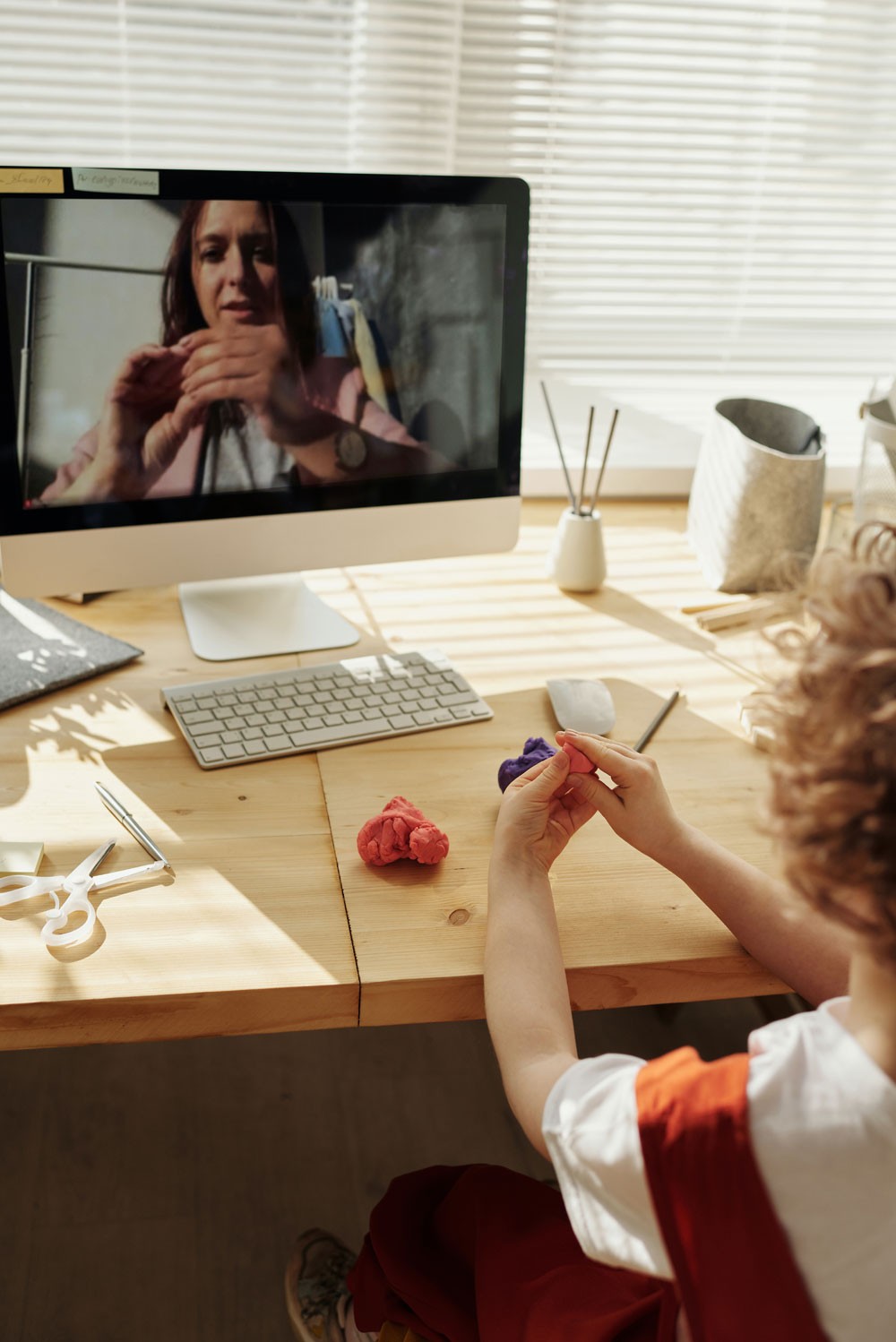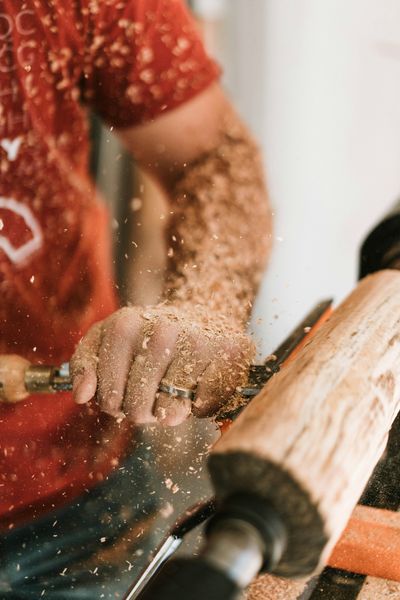Of course remote craft courses can be a great alternative, or preference, to in-person craft courses! Although the answer is a little more complicated than that because in reality it depends on the type of person you are and the type of craft you want to learn.
And what actually is a remote craft course anyway?
 Remote learning; is it any good?
Remote learning; is it any good?
So to start with let’s look at why you want to learn a new craft?
Just as life is complicated, so is how we learn. How effective a craft course can be completely depends on your needs, what craft you wish to learn, what type of learner you are, what you are looking to get out of the experience, and the quality of the tutor (thankfully we can help out with lots of great ones!).
To really get to the heart of what would work for you really depends on what is driving you to do a craft course. Is it:
- connecting with people?
- getting access to experts?
- meeting likeminded people?
- learning techniques or improving skills?
- finding a hobby or pastime?
- developing lifelong skills or a career?
What is an online craft course or remote learning?
There are advantages and disadvantages to the ways in which we learn anything new. Of course going to a dedicated place of learning is the most straightforward way and it's what we're all accustomed to, but the world has changed and there are now lots of great ways to learn remotely.
Live online classes (via Zoom or similar)
This is the classic internet learning format – everyone logs into the class from home at a specific time via their computer or smartphone and the tutor gives the lesson using their camera. It's almost the same as being there; it's live, and you can ask questions and interact with the tutor and the other students. Class sizes can range from one-to-one to many hundreds. It's a fun way to learn, works well, and is rapidly being adopted around the world by schools and universities.
This format of online learning is a little different from live classes; the videos are pre-recorded, you're provided with downloadable instructions, course content is delivered via web based presentations, and so on. You watch them and follow along whenever you want at your own pace. You can press pause to make yourself a cup of tea, do an insomniac's half hour in the middle of the night... you're in charge. You can still contact the tutor via email (or similar) so support is always available, and often you'll have access to accompanying resources online. And sometimes your tutor will have set up an online group so fellow students can chat, ask questions, and share their experiences.
Learning a craft remotely often requires specialist materials and equipment. Often the course provider will have a complete 'craft in a box' kit that they can send to you in the post with materials and instructions and guides. The beauty of this is that it removes the need for shopping lists; everything you need is delivered to your door. All that's left for you to do is get started and have fun!
Craft books are still massively popular, and learning a craft from a book is a wonderful way to tackle a new skill. You can work through the lessons or exercises at your own pace, everything is laid out clearly with easy-to-follow instructions, all accompanied by inspiring photographs - nothing beats a good book!
 Craft in a box - everything you need to start learning!
Craft in a box - everything you need to start learning!
Why are we talking about remote learning?
The world has changed dramatically this year because of coronavirus, and people have been forced to modify the way they live their lives and conduct their business. This of course includes the thousands of expert tutors providing arts, crafts and wellbeing workshops, classes and courses across the UK.
“The crafts are an important part of our social and economic life with ... craft sales worth £3 billion to the UK economy,” said Rosy Greenlees, Executive Director of the Crafts Council. “However it is a sector dominated by micro enterprises and sole practitioners. The impact of covid-19 has cut off access to workshops and studios, blocked supplies and sales, shut down fairs and galleries but most importantly left craft businesses without an income.”
Many craft courses have evolved
Whilst it's true that for some the impact has been catastrophic, others have been able to adapt their offerings so they can continue to deliver their classes in different ways.
For the lucky ones amongst us learning a new craft is still as simple as signing up to an exciting new course and popping down to the local college to join in (whilst wearing a facemask and observing social distancing rules).
For others, however, who are at risk and who need to stay at home for example, luckily many craft courses have evolved to take place remotely so you can continue to benefit from all that learning a new craft has to offer.
Remote learning has become even more relevant now, and it looks like it is here to stay, alongside in-person courses, because of the many advantages.
 Some craft courses have evolved to take place online
Some craft courses have evolved to take place online
So is remote learning the future for craft courses?
Whilst learning remotely has many benefits, there are also some drawbacks, and different formats (online, live, kits, books, in-person) will answer different students’ needs, work differently for different crafts, and suit different wider circumstances.
The advantages of remote craft courses
- You can carry on learning regardless of what's happening in the world
There may be a global pandemic going on out there but, thanks to remote learning, you can continue to learn your new craft. - Learn from anywhere
You could be up a mountain, at home with a broken leg... as long as you have your books, some kit, the tools, the guide, or the internet, you can still learn. - Access to lots more courses, not just local ones
Maybe no-one in your town offers macramé courses so it's a dream you've never managed to fulfil. But learning remotely means you don't need to be there in person so you can join whichever remote course takes your fancy. - No travel, no parking
Travelling to a course can be expensive, time-consuming, stressful, and potentially difficult. And if you've driven there you'll have to find somewhere to park and maybe pay for it. Remote learning removes all of these issues. - Flexible scheduling
Rather than having to attend a 9:00am class every week for a month, you can in some cases choose when you learn, so you can do it around your work schedule, family life, and other commitments. - Better for the environment
Removing the need to travel has a huge impact on your carbon footprint. Research has shown, for example, that teaching 100 students online rather than in person can lead to a reduction in CO2 emissions of 10 tonnes per term. - Less stressful
For those of us who suffer from anxiety, learning from the reassuring comfort of home can be a huge relief. Removing the requirement to struggle with the outside world and social interactions leaves you free to concentrate on enjoying learning your new skill.
The possible drawbacks of remote craft courses
- No face-to-face interaction
Remote learning doesn't completely replicate the human interaction that happens in a face-to-face learning environment. When a tutor is physically in front of you, you can read their body language, pick up on subtle gestures, sense the mood of the room, etc. You can also engage in spontaneous conversations with classmates that is a useful part of the learning experience. These things all combine to help you learn. - Less social
For a lot of us, attending a course is as much about meeting up with friends as it is learning something new. Whilst live online courses still have a social element, it's nothing like being with other people in real life. - You're responsible for your learning
Oftentimes it will be up to you to do the suggested reading, work on the recommended exercises, and so on. You will need to be self-motivated and self-organised. - You can't learn everything from a distance
It's far easier to learn needlework or painting using the available remote learning options than say blacksmithing, glasswork or dry stone walling, but many clever tutors are finding ways to give students a taste of their crafts at home, and also creating an ingenious mix of remote and in-person courses to cover as wide a range of subjects as possible.
A balanced approach to learning
It would be easier to just say that from now we'll all be learning crafts a certain way and that it suited everybody and worked perfectly. But the reality is that the way we learn is complicated and varied, and that a mixture of formats is the ideal way of doing things in many cases.
You may get yourself a needle felt kit, enjoy doing that at home, and be satisfied with the result and the experience. Or you may join in with a one-off in-person jewellery course at a local venue to make the ring you always wanted. Others amongst you might start with a leather bag-making kit at home which may trigger the desire to go on to do more, joining live courses for different items, and then more intensive leatherwork courses in-person to really hone your leather skills.
Remote learning is a welcome addition to the way we acquire new crafting skills, and one that is definitely here to stay, either on its own or as part of a mix of ways to learn.
 A 'pick and pix' approach to learning means you really can do what suits you best.
A 'pick and pix' approach to learning means you really can do what suits you best.
Being creative is good for you so it's important to keep crafting
You probably already know this but being creative is really good for you and your mental health, so being able to continue crafting is important. Perhaps even more so now than ever before it's vital that craft tutors out there can carry on teaching so we can continue to learn, so if you can't get to your class in person, that's no reason not to carry on crafting!
Why crafting can help during isolation
Taking care of your mental health is important, especially whilst social distancing. Isolation can cause anxiety, depression and various other wellbeing issues. One way for you to cope with negative feelings is through crafting and here we explain how and why.
The health benefits of craft
It is time to recognise the powerful contribution the arts can make to health and wellbeing. They can help keep us well, aid our recovery and support longer lives better lived.



